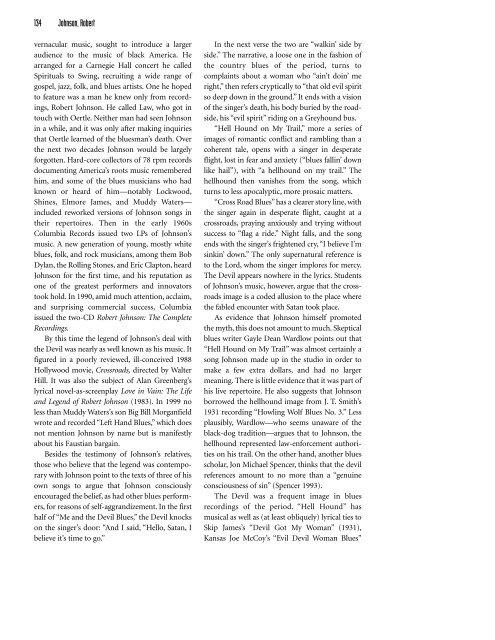Satanism Today - An Encyclopedia of Religion, Folklore and Popular ...
Satanism Today - An Encyclopedia of Religion, Folklore and Popular ...
Satanism Today - An Encyclopedia of Religion, Folklore and Popular ...
You also want an ePaper? Increase the reach of your titles
YUMPU automatically turns print PDFs into web optimized ePapers that Google loves.
134 Johnson, Robert<br />
vernacular music, sought to introduce a larger<br />
audience to the music <strong>of</strong> black America. He<br />
arranged for a Carnegie Hall concert he called<br />
Spirituals to Swing, recruiting a wide range <strong>of</strong><br />
gospel, jazz, folk, <strong>and</strong> blues artists. One he hoped<br />
to feature was a man he knew only from recordings,<br />
Robert Johnson. He called Law, who got in<br />
touch with Oertle. Neither man had seen Johnson<br />
in a while, <strong>and</strong> it was only after making inquiries<br />
that Oertle learned <strong>of</strong> the bluesman’s death. Over<br />
the next two decades Johnson would be largely<br />
forgotten. Hard-core collectors <strong>of</strong> 78 rpm records<br />
documenting America’s roots music remembered<br />
him, <strong>and</strong> some <strong>of</strong> the blues musicians who had<br />
known or heard <strong>of</strong> him—notably Lockwood,<br />
Shines, Elmore James, <strong>and</strong> Muddy Waters—<br />
included reworked versions <strong>of</strong> Johnson songs in<br />
their repertoires. Then in the early 1960s<br />
Columbia Records issued two LPs <strong>of</strong> Johnson’s<br />
music. A new generation <strong>of</strong> young, mostly white<br />
blues, folk, <strong>and</strong> rock musicians, among them Bob<br />
Dylan, the Rolling Stones, <strong>and</strong> Eric Clapton, heard<br />
Johnson for the first time, <strong>and</strong> his reputation as<br />
one <strong>of</strong> the greatest performers <strong>and</strong> innovators<br />
took hold. In 1990, amid much attention, acclaim,<br />
<strong>and</strong> surprising commercial success, Columbia<br />
issued the two-CD Robert Johnson: The Complete<br />
Recordings.<br />
By this time the legend <strong>of</strong> Johnson’s deal with<br />
the Devil was nearly as well known as his music. It<br />
figured in a poorly reviewed, ill-conceived 1988<br />
Hollywood movie, Crossroads, directed by Walter<br />
Hill. It was also the subject <strong>of</strong> Alan Greenberg’s<br />
lyrical novel-as-screenplay Love in Vain: The Life<br />
<strong>and</strong> Legend <strong>of</strong> Robert Johnson (1983). In 1999 no<br />
less than Muddy Waters’s son Big Bill Morganfield<br />
wrote <strong>and</strong> recorded “Left H<strong>and</strong> Blues,” which does<br />
not mention Johnson by name but is manifestly<br />
about his Faustian bargain.<br />
Besides the testimony <strong>of</strong> Johnson’s relatives,<br />
those who believe that the legend was contemporary<br />
with Johnson point to the texts <strong>of</strong> three <strong>of</strong> his<br />
own songs to argue that Johnson consciously<br />
encouraged the belief, as had other blues performers,<br />
for reasons <strong>of</strong> self-aggr<strong>and</strong>izement. In the first<br />
half <strong>of</strong> “Me <strong>and</strong> the Devil Blues,” the Devil knocks<br />
on the singer’s door: “<strong>An</strong>d I said, “Hello, Satan, I<br />
believe it’s time to go.”<br />
In the next verse the two are “walkin’ side by<br />
side.” The narrative, a loose one in the fashion <strong>of</strong><br />
the country blues <strong>of</strong> the period, turns to<br />
complaints about a woman who “ain’t doin’ me<br />
right,” then refers cryptically to “that old evil spirit<br />
so deep down in the ground.” It ends with a vision<br />
<strong>of</strong> the singer’s death, his body buried by the roadside,<br />
his “evil spirit” riding on a Greyhound bus.<br />
“Hell Hound on My Trail,” more a series <strong>of</strong><br />
images <strong>of</strong> romantic conflict <strong>and</strong> rambling than a<br />
coherent tale, opens with a singer in desperate<br />
flight, lost in fear <strong>and</strong> anxiety (“blues fallin’ down<br />
like hail”), with “a hellhound on my trail.” The<br />
hellhound then vanishes from the song, which<br />
turns to less apocalyptic, more prosaic matters.<br />
“Cross Road Blues” has a clearer story line, with<br />
the singer again in desperate flight, caught at a<br />
crossroads, praying anxiously <strong>and</strong> trying without<br />
success to “flag a ride.” Night falls, <strong>and</strong> the song<br />
ends with the singer’s frightened cry, “I believe I’m<br />
sinkin’ down.” The only supernatural reference is<br />
to the Lord, whom the singer implores for mercy.<br />
The Devil appears nowhere in the lyrics. Students<br />
<strong>of</strong> Johnson’s music, however, argue that the crossroads<br />
image is a coded allusion to the place where<br />
the fabled encounter with Satan took place.<br />
As evidence that Johnson himself promoted<br />
the myth, this does not amount to much. Skeptical<br />
blues writer Gayle Dean Wardlow points out that<br />
“Hell Hound on My Trail” was almost certainly a<br />
song Johnson made up in the studio in order to<br />
make a few extra dollars, <strong>and</strong> had no larger<br />
meaning. There is little evidence that it was part <strong>of</strong><br />
his live repertoire. He also suggests that Johnson<br />
borrowed the hellhound image from J. T. Smith’s<br />
1931 recording “Howling Wolf Blues No. 3.” Less<br />
plausibly, Wardlow—who seems unaware <strong>of</strong> the<br />
black-dog tradition—argues that to Johnson, the<br />
hellhound represented law-enforcement authorities<br />
on his trail. On the other h<strong>and</strong>, another blues<br />
scholar, Jon Michael Spencer, thinks that the devil<br />
references amount to no more than a “genuine<br />
consciousness <strong>of</strong> sin” (Spencer 1993).<br />
The Devil was a frequent image in blues<br />
recordings <strong>of</strong> the period. “Hell Hound” has<br />
musical as well as (at least obliquely) lyrical ties to<br />
Skip James’s “Devil Got My Woman” (1931),<br />
Kansas Joe McCoy’s “Evil Devil Woman Blues”
















